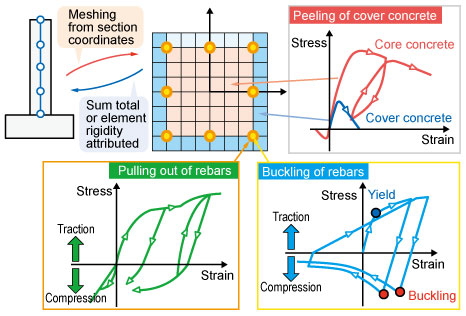3. Method for evaluating structural safety considering residual resistance during a major earthquake
- An analysis method was developed which makes it possible to evaluate the behaviour of major deformation areas for structures as a whole or individual components.
- A proposal was made for a practical safety assessment method which could be applied for both main shock and aftershocks of a major earthquake.
Under current design standards, given the difficulty of structural analysis in areas subject to large deformation and in consideration of earthquake aftershocks, evaluations tend ultimately towards the safeside. However, in the case of an earthquake exceeding a magnitude of 8, seismic motion may be greater than the standard earthquake ground motion used for todayfs design standards. As such, a more rational evaluation method needed to be developed. Consequently a method has been proposed which can evaluate structural seismic performance to resist a massive earthquake which also takes into account the impact of resulting aftershocks.
A fibre model which can evaluate large deformation area phenomena by changing its formulation from infinitesimal deformation theory to finite deformation, and by introducing the elements which take into account rebar buckling or concrete exfoliation (Fig.1). This approach can pinpoint certain types of behaviour, such as areas in which a material has lost its resistance.
A new algorithm was proposed, which can detect the overall instability of a structure by successive application of eigenvalue analyses using stiffness, which corresponds to the state of damage.
Up until today, the overall state of a structure was defined by the ultimate condition of one of the constituent materials of the overall structure. However, with this method, the ultimate state of a structure is defined by its overall condition, rather than that of its individual components. This new method therefore provides a more rational evaluation in the case of an extremely large earthquake. In addition, given that the aftershocks accompanying an extreme earthquake are likely to be very large themselves, it is crucial to take them into consideration too.
A nomogram called gseismic residual resistance rate spectrumh was developed by using the method described above. This nomogram makes it possible to practically evaluate structural safety not only during the main quake but also during aftershocks.
Based on the above, it is now possible to carry out rational, high precision seismic resistance diagnoses for extremely large scale earthquakes which also take into account aftershocks.

Fig.1 Fibre model concept